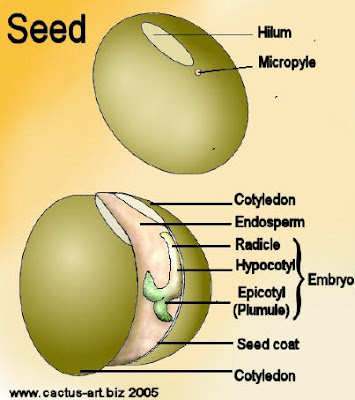Seeds consist of three parts: (1) the embryo, (2) the food storage tissue, and (3) the seed coat.
The embryo is the part of the seed from which the mature plant develops. It contains the parts that develop into the primary root, the first root to grow; the stem; and the first leaves of the new plant. The embryo also has one or more specialized leaflike structures called cotyledons. Angiosperms have either one or two cotyledons. Those with one cotyledon are called monocotyledons or monocots. Angiosperms with two cotyledons are called dicotyledons or dicots. Gymnosperms have from two to eight cotyledons.
The cotyledons absorb and digest food from the food storage tissue of the seed. In angiosperm seeds, this tissue is called the endosperm. The cotyledons of some dicotyledon seeds quickly absorb all the food in the endosperm. The cotyledons then store the food that the embryo needs for growth. In gymnosperm seeds, food is stored in tissue called the megagametophyte.
The seed coat covers the embryo and food storage tissue and protects them from injury, insects, and loss of water. Seed coats range from thin, delicate layers of tissue to thick, tough coverings.








